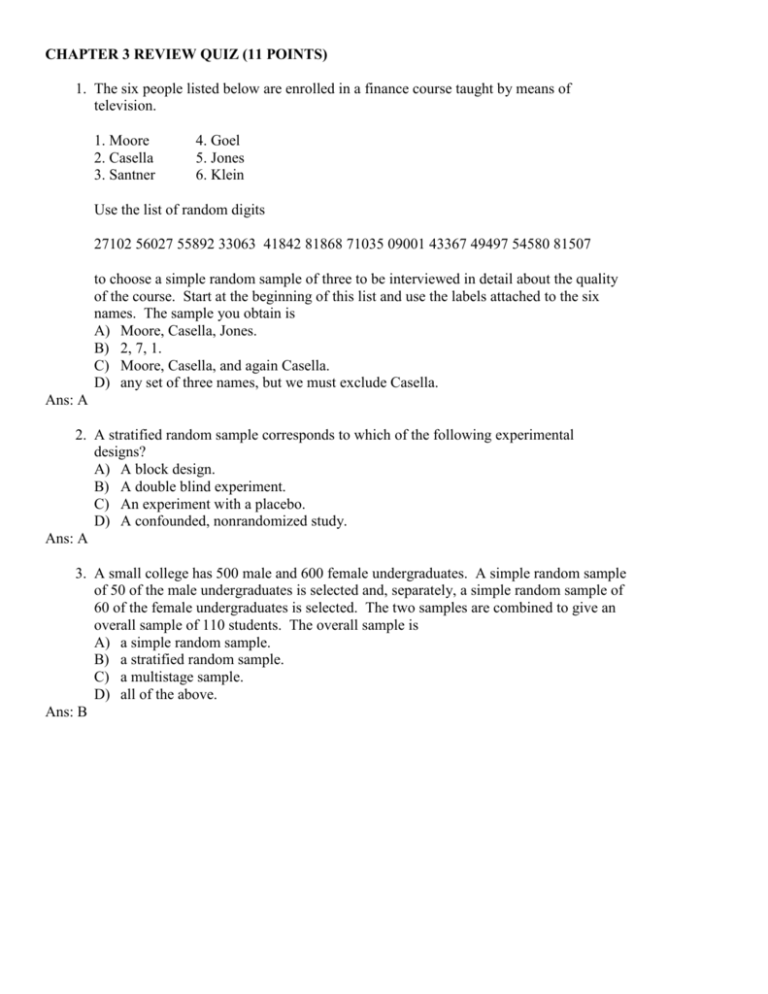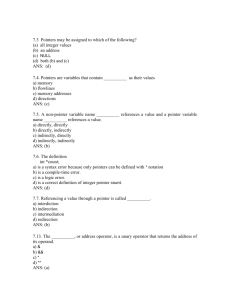CHAPTER 3 REVIEW QUIZ (11 POINTS) 1. The six people listed
advertisement

CHAPTER 3 REVIEW QUIZ (11 POINTS) 1. The six people listed below are enrolled in a finance course taught by means of television. 1. Moore 2. Casella 3. Santner 4. Goel 5. Jones 6. Klein Use the list of random digits 27102 56027 55892 33063 41842 81868 71035 09001 43367 49497 54580 81507 to choose a simple random sample of three to be interviewed in detail about the quality of the course. Start at the beginning of this list and use the labels attached to the six names. The sample you obtain is A) Moore, Casella, Jones. B) 2, 7, 1. C) Moore, Casella, and again Casella. D) any set of three names, but we must exclude Casella. Ans: A 2. A stratified random sample corresponds to which of the following experimental designs? A) A block design. B) A double blind experiment. C) An experiment with a placebo. D) A confounded, nonrandomized study. Ans: A 3. A small college has 500 male and 600 female undergraduates. A simple random sample of 50 of the male undergraduates is selected and, separately, a simple random sample of 60 of the female undergraduates is selected. The two samples are combined to give an overall sample of 110 students. The overall sample is A) a simple random sample. B) a stratified random sample. C) a multistage sample. D) all of the above. Ans: B 4. A 1992 Roper poll found that 22% of Americans say that the Holocaust may not have happened. The actual question asked in the poll was “Does it seem possible or impossible to you that the Nazi extermination of the Jews never happened?” and 22% responded possible. The results of this poll cannot be trusted because A) undercoverage is present. Obviously those people who did not survive the Holocaust could not be in the poll. B) the question is worded in a confusing manner. C) we do not know who conducted the poll or who paid for the results. D) nonresponse is present. Many people will refuse to participate and those that do will be biased in their opinions. Ans: B 5. In order to take a sample of 90 members of a local gym, I first divide the members into men and women, and then take a simple random sample of 45 men and a separate simple random sample of 45 women. This is an example of a A) block design. B) stratified random sample. C) double blind simple random sample. D) randomized comparative experiment. Ans: B Use the following to answer questions 4-6: Sickle cell disease is a painful disorder of the red blood cells that affects mostly Blacks in the United States. To investigate whether the drug hydroxyurea can reduce the pain associated with sickle cell disease, a study by the National Institute of Health has eight subjects available with sickle cell disease. The researchers are going to give the drug to four of the subjects and a placebo to the other four. They will then count the number of episodes of pain reported by each subject. 6. The names of the eight subjects are given below. 1. Blumenthal 5. House 2. Costello 6. Long 3. Duvall 7. Pavlicova 4. Fan 8. Tang Using the list of random digits, 81507 27102 56027 55892 33063 41842 81868 71035 09001 43367 49497 starting at the beginning of this list and using single digit labels, you assign the first four subjects selected to receive the drug hydroxyurea, while the remainder receive the placebo. The subjects assigned to the placebo are A) Blumenthal, Costello, Duvall, and Fan. B) Blumenthal, House, Pavlicova, and Tang. C) House, Long, Pavlicova, and Tang. D) Costello, Duvall, Fan, and Long. Ans: D 7. The response is A) the drug hydroxyurea. B) the number of episodes of pain. C) the presence of sickle cell disease. D) the number of red blood cells. Ans: B 8. The experimental units are A) the subjects who experienced the most episodes of pain. B) the four subjects who received the drug hydroxyurea. C) the four subjects who received the placebo. D) the eight subjects. Ans: D Use the following to answer questions 7-9: Twelve people who suffer from chronic fatigue syndrome volunteer to take part in an experiment to see if shark fin extract will increase one's energy level. Eight of the volunteers are men and four are women. Half of the volunteers are to be given shark fin extract twice a day and the other half a placebo twice a day. We wish to make sure that four men and two women are assigned to each of the treatments, so we decide to use a block design with the men forming one block and the women the other. 9. A block design is appropriate in this experiment if A) we believe men and women will respond differently to treatments. B) gender equity is an important legal consideration in this study. C) we want the conclusions to apply equally to men and women. D) all of the above. Ans: A 10. Suppose one of the researchers is responsible for determining if a subject displays an increase in energy level. In this case, we should probably A) use two placeboes. B) use stratified sampling to assign subjects to treatments. C) use fewer subjects but observe them more frequently. D) conduct the study as a double blind experiment. Ans: D 11. A study to determine whether or not a kicking a football filled with helium traveled farther than one filled with air found that, while the football filled with helium went, on average, farther than the one filled with air, the difference was not statistically significant. The response A) is the gas, air or helium, with which the football is filled. B) does not exist without statistical significance. C) is the number of kickers. D) is the distance which the football traveled. Ans: D Use the following to answer questions 10-11: One hundred volunteers who suffer from severe depression are available for a study. Fifty are selected at random and are given a new drug, which is thought to be particularly effective in treating severe depression. The other 50 are given an existing drug for treating severe depression. A psychiatrist evaluates the symptoms of all volunteers after four weeks in order to determine if there has been substantial improvement in the severity of the depression. 12. The factor in this study is A) which treatment the volunteers receive. B) the use of randomization and the fact that this was a comparative study. C) the extent to which the depression was reduced. D) the use of a psychiatrist to evaluate the severity of depression. Ans: A 13. This study would be double blind if A) neither drug had any identifying marks on it. B) all volunteers were not allowed to see the psychiatrist nor the psychiatrist allowed to see the volunteers during the session in which the psychiatrist evaluated the severity of the depression. C) neither the volunteers nor the psychiatrist knew which treatment any person had received. D) All of the above. Ans: C









